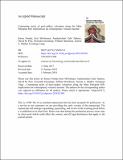Files in this item
Contrasting styles of post-caldera volcanism along the Main Ethiopian Rift : implications for contemporary volcanic hazards
Item metadata
| dc.contributor.author | Fontijn, Karen | |
| dc.contributor.author | McNamara, Keri | |
| dc.contributor.author | Tadesse, Amdemichael Zafu | |
| dc.contributor.author | Pyle, David M. | |
| dc.contributor.author | Dessalegn, Firawalin | |
| dc.contributor.author | Hutchison, William | |
| dc.contributor.author | Mather, Tamsin A. | |
| dc.contributor.author | Yirgu, Gezahegn | |
| dc.date.accessioned | 2019-02-12T00:34:09Z | |
| dc.date.available | 2019-02-12T00:34:09Z | |
| dc.date.issued | 2018-05-01 | |
| dc.identifier | 252276086 | |
| dc.identifier | a05de5f7-fc3f-48e6-9b50-4b78b949e3e8 | |
| dc.identifier | 85042869465 | |
| dc.identifier | 000435049900006 | |
| dc.identifier.citation | Fontijn , K , McNamara , K , Tadesse , A Z , Pyle , D M , Dessalegn , F , Hutchison , W , Mather , T A & Yirgu , G 2018 , ' Contrasting styles of post-caldera volcanism along the Main Ethiopian Rift : implications for contemporary volcanic hazards ' , Journal of Volcanology and Geothermal Research , vol. 356 , pp. 90-113 . https://doi.org/10.1016/j.jvolgeores.2018.02.001 | en |
| dc.identifier.issn | 0377-0273 | |
| dc.identifier.other | RIS: urn:5E4502557916AB445C3D92981D0F98AA | |
| dc.identifier.uri | https://hdl.handle.net/10023/17041 | |
| dc.description | This work was funded by the Natural Environment Research Council grant NE/L013932/1 (RiftVolc) and a Boise Fund grant from the Department of Zoology, University of Oxford. | en |
| dc.description.abstract | The Main Ethiopian Rift (MER, ~7–9°N) is the type example of a magma-assisted continental rift. The rift axis is populated with regularly spaced silicic caldera complexes and central stratovolcanoes, interspersed with large fields of small mafic scoria cones. The recent (latest Pleistocene to Holocene) history of volcanism in the MER is poorly known, and no eruptions have occurred in the living memory of the local population. Assessment of contemporary volcanic hazards and associated risk is primarily based on the study of the most recent eruptive products, typically those emplaced within the last 10–20 ky. We integrate new and published field observations and geochemical data on tephra deposits from the main Late Quaternary volcanic centres in the central MER to assess contemporary volcanic hazards. Most central volcanoes in the MER host large mid-Pleistocene calderas, with typical diameters of 5–15 km, and associated ignimbrites of trachyte and peralkaline rhyolite composition. In contrast, post-caldera activity at most centres comprises eruptions of peralkaline rhyolitic magmas as obsidian flows, domes and pumice cones. The frequency and magnitude of events varies between individual volcanoes. Some volcanoes have predominantly erupted obsidian lava flows in their most recent post-caldera stage (Fentale), whereas other have had up to 3 moderate-scale (VEI 3–4) explosive eruptions per millennium (Aluto). At some volcanoes we find evidence for multiple large explosive eruptions (Corbetti, Bora-Baricha, Boset-Bericha) which have deposited several centimeters to meters of pumice and ash in currently densely populated regions. This new overview has important implications when assessing the present-day volcanic hazard in this rapidly developing region. | |
| dc.format.extent | 48164511 | |
| dc.language.iso | eng | |
| dc.relation.ispartof | Journal of Volcanology and Geothermal Research | en |
| dc.subject | Main Ethiopian Rift | en |
| dc.subject | Volcanic hazards | en |
| dc.subject | Calderas | en |
| dc.subject | Peralkaline rhyolite | en |
| dc.subject | Explosive eruptions | en |
| dc.subject | QE Geology | en |
| dc.subject | GE Environmental Sciences | en |
| dc.subject | DAS | en |
| dc.subject.lcc | QE | en |
| dc.subject.lcc | GE | en |
| dc.title | Contrasting styles of post-caldera volcanism along the Main Ethiopian Rift : implications for contemporary volcanic hazards | en |
| dc.type | Journal article | en |
| dc.contributor.institution | University of St Andrews. School of Earth & Environmental Sciences | en |
| dc.identifier.doi | 10.1016/j.jvolgeores.2018.02.001 | |
| dc.description.status | Peer reviewed | en |
| dc.date.embargoedUntil | 2019-02-12 |
This item appears in the following Collection(s)
Items in the St Andrews Research Repository are protected by copyright, with all rights reserved, unless otherwise indicated.

